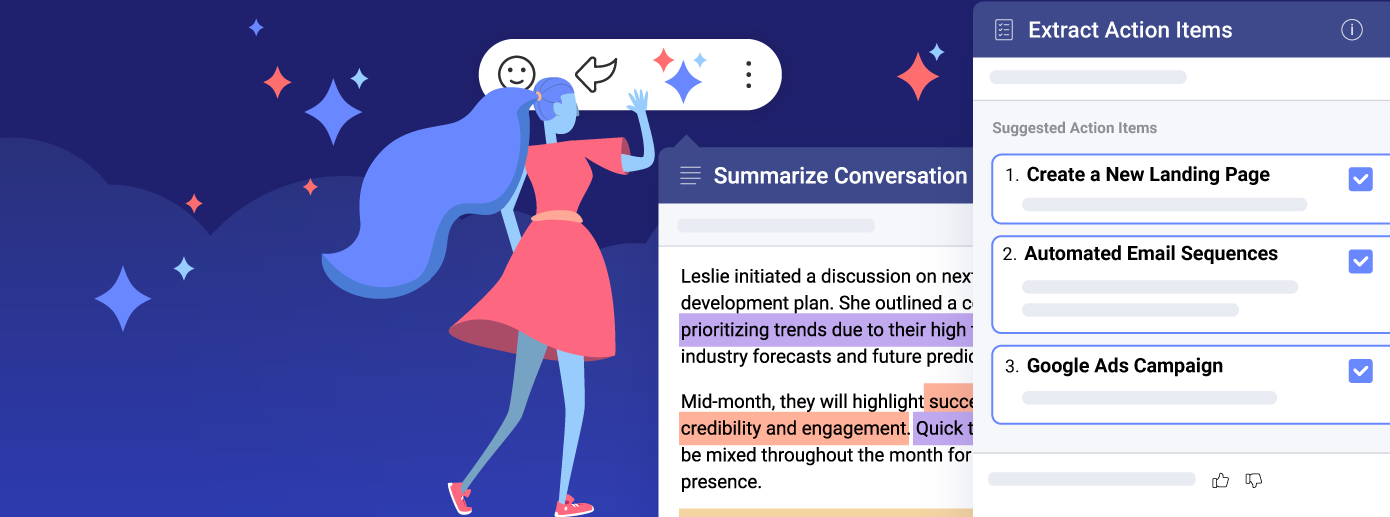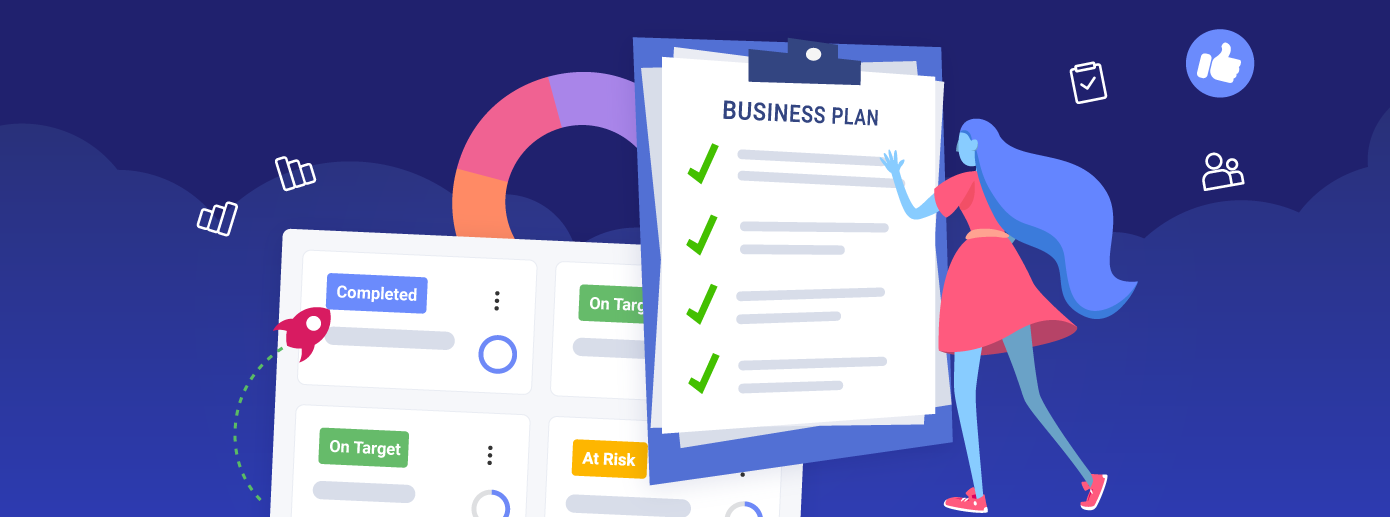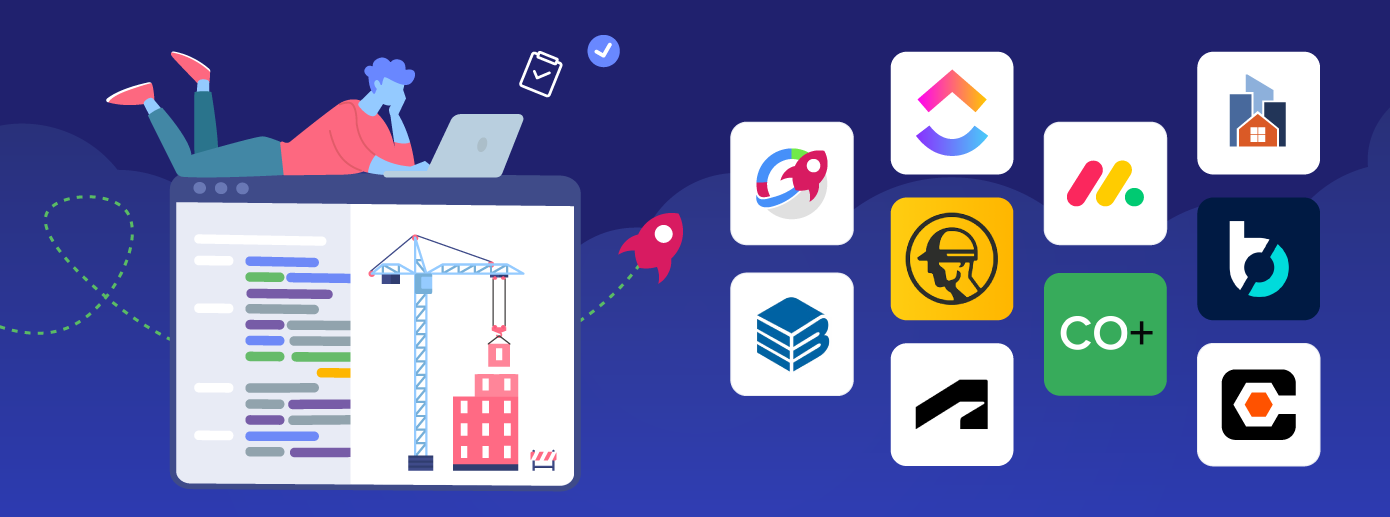
Scrum vs. Waterfall: How to Choose the Right Method for your Project
There are different benefits to using each of the two most popular project management methodologies - Scrum and Waterfall. Understanding specifically the differences between the two methodologies, their pros, and cons and the benefits project managers experience by using each one. In this article, we take a closer look at Scrum vs. Waterfall, to give you just that perspective.
Executive Summary:
There are different benefits to using each of the two most popular project management methodologies - Scrum and Waterfall. Understanding specifically the differences between the two methodologies, their pros, and cons and the benefits project managers experience by using each one. In this article, we take a closer look at Scrum vs. Waterfall, to give you just that perspective.
In project management, especially when it comes to web development, using the appropriate project management methodology is vital. Choosing to implement a method to help your team’s processes while finding the process that works best for your use case and team is something every project manager and organization comes to head with.
It’s an important decision mostly because the choice of methodology might mean an easier process – or not so much. Different methodologies use different frameworks for designing and managing the development process.
Choosing one or the other could depend hugely on the type of project or organizational goals, but both approaches are currently actively being used in the process of software development.
What Is Scrum?
Тhe Scrum methodology is а subset of the Agile methodology and the most popular process framework that implements Agile. It was created in 1993 by Jeff Sutherland, who adapted the Scrum formation used by Rugby teams for software development. The three pillars Scrum is built on are:
- Transparency
- Inspection
- Adaptation
The approach is used to deliver a ready product efficiently through a set of meetings, tools, and roles to assist teams in their work. Scrum works through fixed-length iterations on each project until its completion, called sprints. At the end of each sprint, which usually lasts up to two weeks, a meeting is held to discuss the next steps in the project. Scrum follows few basic elements that provide structure to it:
- Sprint planning: the event that kicks off the sprint and defines what is to be delivered in its duration
- Daily stand up: a short daily meeting that lets the team plan its work for the current day, and discuss potential obstacles or issues
- Sprint demo: a review of the completed backlog items through demonstration
- Sprint retrospective: a recurring meeting at the end of the spring that consists of discussing overall workflow improvements while preparing for the next sprint
The Scrum method uses visual aids during each sprint, like tasks boards, charts, and process visuals, so people are always aware of the progress and feedback can be provided continuously. The approach depends on the members of the team to take on specific key roles in the development process, as follows:
- Scrum master – the person who facilitates the team and makes sure the best practices and tools are used at all times. The scrum master moves the project forward by keeping track of things and helps address any issues the team might have with the execution of their tasks
- Product owner – the person who acts as a link between the customer and the development team, responsible for clearly communicating the expectations toward the project’s execution
- Development team – the people responsible for creating and testing the final product, executing each release until completion
Scrum is a method that works great for complex and innovative projects, delivering solutions with a focus on project management.
What is Waterfall methodology?
Тhe Waterfall methodology follows a chronological process of work that, like Scrum, is based on three main pillars, namely:
- Fixed dates
- Requirements
- Outcomes
Waterfall is generally a more conservative approach but still is used a lot in 2021. In it, teams work more independently and the project management is linear – requirements are gathered at the start of the project and a project plan is created per those requirements. Because each phase of the project cascades into the next, thus the name of the methodology logically represents this ‘waterfall’ movement.
The Waterfall methodology consists of five primary stages.
- Requirements – this is the gathering of all customer requirements before the start of the project that enables the planning of each following phase
- Design – this includes logical design and physical design: brainstorming solutions and turning them into specifications
- Implementation – when developers take all requirements and specifications and write the code for them
- Verification – releasing the product/solution to the customer so they can review it and make sure it meets the requirements
- Maintenance – the customer starts regularly using the finished product, reporting and tracking bugs or features that do not work so the production team can fix them
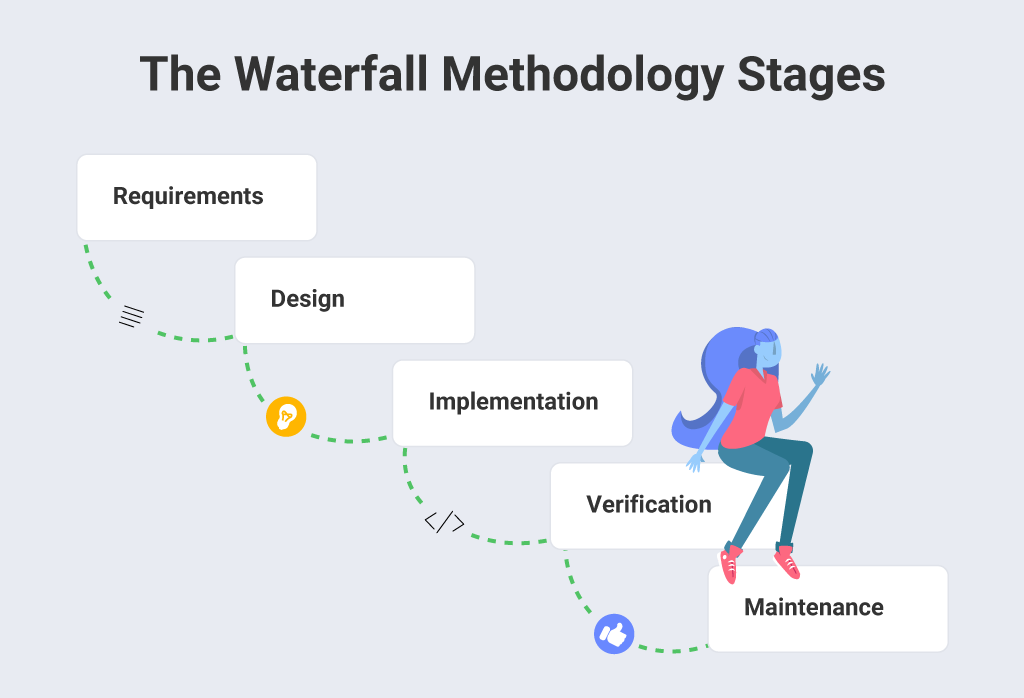
With Waterfall, teams work more independently and are not required to be in continuous communication or giving reports continuously. Тeams are grouped by function and when each team finishes their part, they “hand it over” to the next team who needs to continue the development.
Project management
Seamlessly manage tasks, teams, and projects of any complexity from start to finish.
Use Template →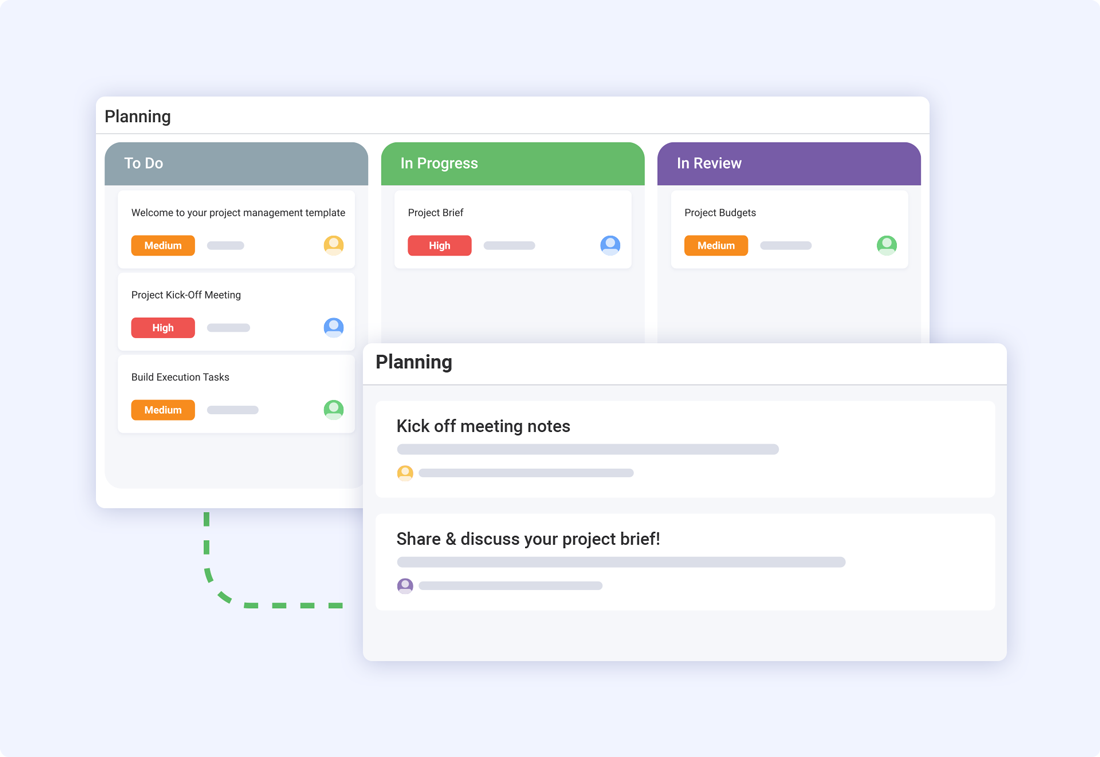
How Does Scrum work?
As a framework, Scrum helps the team work together and execute a project through being a close-knit, constantly communicating unit. Everyone working in Scrum is encouraged to self-organize and improve themselves constantly, but also stay in contact and communicate any potential blockers for their work. The structure of Scrum consists of several never-changing components, events, ceremonies, and meetings that need to happen regularly. Here are some of the most popular steps and tools usually used in Scrum.
- Product backlog – a recurring meeting between the Product Owner and the development team, to prioritize the items and desired features that need to be completed in the current sprint
- Backlog refinement – also called Backlog grooming, is the meeting at the end of each sprint between the Product Owner and the development team to determine if the backlog is ready for the next sprint and ensure only relevant items and objectives are selected for it
- Sprint planning – the meeting before each spring where the Product Owner presents the top items for execution and the team chooses which ones to complete during this sprint
- Daily Scrum Meeting – the already mentioned 15-minute daily stand-up meeting to discuss dependencies, goals, and potential issues
- Sprint review – the meeting at the end of each sprint to present the completed work, with a live demonstration
- Sprint retrospective – the meeting to reflect how and what changes need to be made in the next sprint, what went well, and what could be improved
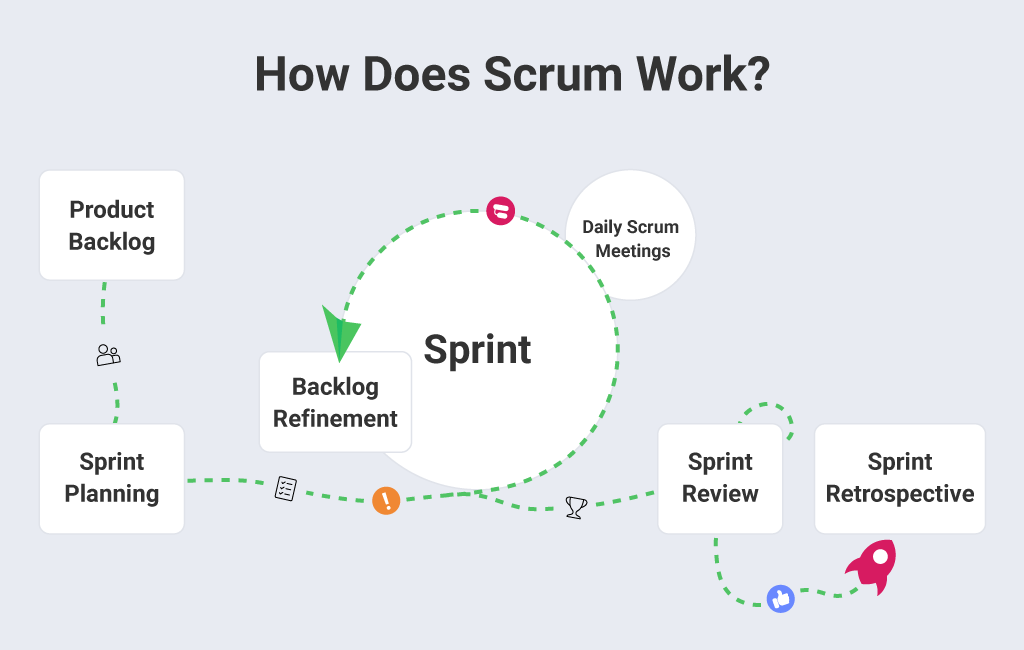
Besides these meetings called ceremonies, the Scrum methodology uses several tools to help move the work along. One example is the Scrum board is used to visualize the sprint backlog, using post-it notes or index cards. A Scrum board has three main categories: to do, in progress, and done, and is updated throughout the sprint by the team when a new task comes up, for instance.
Аnother tool used is User stories – short stories that describe a software feature from the customer perspective and are used to create code to meet it. With a Burndown chart, which is another tool used to show clearly all outstanding work, the remaining items are represented through story points, ideal days, team days, etc. so everyone is aware of how to plan and if any blockers stop the work. Another term you will often come across in Scrum is Timeboxing, which is a set period the team will allocate to a specific goal and will stop work when the period is near its end.
How Does Waterfall Methodology Work?
The Waterfall methodology is usually chosen for projects that offer a very clear picture of how things need to happen from the get-go – meaning, all requirements are provided in the beginning and are very unlikely to change until the end. Cost, period, and design are set from the start in the Waterfall model.
Here are some tools and techniques by which Waterfall operates successfully.
- Gantt chart – a tool project managers use when working in Waterfall, that allows for the mapping of subtasks, dependencies, and phases of the project. Each task’s duration can be set in Gantt and tasks that are dependent on one another can be linked with dependencies
- Collection of documents – since the beginning, all requirement documents need to be present in Waterfall, and there may even be a dedicated team for collecting them through interviews, questionnaires, whiteboards and other tools
- A template for tasks – many tasks will be required for completing the final product, so in Waterfall methodology, project managers try and plan each of those tasks in a breakdown structure, in a template that helps the team figure out each step of the way
Advantages and Disadvantages of Scrum
Scrum is often thought to be the favored methodology in software development, but it’s also often adopted in other fields like Marketing, Sales, Legal, and Management. Like every method, though, it has specific advantages and disadvantages that project managers need to take into account.
Advantages of Scrum include:
- High transparency and visibility – thanks to the daily stand-up meetings, confusion about who’s doing what is mostly eliminated, and issues are identified on the spot.
- Ownership and accountability for everyone – the development team can collectively decide what work they need to complete in each sprint, they collaborate more and ownership and dependencies are always clear
- Course-correcting on the go – because of the constant feedback after each sprint, it’s easier to accommodate changes and add new features for the next sprint or change something for the better
- Better cost-savings – being aware of all potential issues and blockers early on helps to lower expenses and increase the quality
As far as the disadvantages of Scrum go, here are some of them that we cannot skip over.
- The danger of scope creep – because with Scrum the completion date is not set, the customer could continue requesting additional functionalities and features
- Need for familiarity with Scrum – the team needs to know how Scrum functions, accepts and functions well within the methodology. Team members need to have good tech experience and commit to all ceremonies of Scrum for the project’s duration
- The Scrum Master is too important – this role is very tricky and can install a danger of unproductivity of the team. Unlike the Product Manager, the Scrum Master needs to help the team, guide the team, assist the tea, trust the team – but never tell the team what to do or control them in their work
- Poor definition of tasks can lead to delays – if tasks are not well defined, the whole Scrum process could fail and there could be a lot of inaccuracies at the end of each sprint
Advantages and Disadvantages of Waterfall
Even with its proven track record, the Waterfall methodology still has its advantages and disadvantages project managers need to understand, so they make an informed choice.
Advantages include:
- Clarity from the beginning – since the requirements in Waterfall are given at the start and are expected to be thorough and final, each member of the team knows what and when it needs to be done so that they plan their time effectively.
- Accurate estimation of the cost – the total cost of a product or solution can be estimated easily with the clearly defined requirements
- Production is rarely delayed – again because requirements are provided at the start, it’s very rare that new features pop up and more work for the team, and delays are avoided
- Members of the team are flexible – people in specific roles the team could come and go during the project without causing major disruptions when they do
- Milestone-Focused Development – Waterfall is a type of method that embraces deadlines and milestones with a date-focused paradigm, which leads to a clear understanding and preparation for each stage until completion
- Extraordinary discipline – in Waterfall, you have organization and structure that help manage every aspect of the project
Weaknesses of the Waterfall methodology are also worth mentioning before committing to it. Some of them include:
- Longer time for delivery – because it uses a chronological, linear approach, this method could cause longer to deliver the final product
- Delayed testing – since in Waterfall the testing does not start until the product is fully done, most bugs or design problems are discovered pretty late in the process
- Potential disappointment in clients – because the client sees the finished product at the end of the cycle, this could lead to mild disappointments or further requests for changes and new features at a point they are harder to incorporate
Scrum vs. Waterfall: A Side by Side Comparison
If we must pinpoint the main difference between Scrum and Waterfall as methodologies for software development, it would be that Scrum is value-based with shorter iterations and Waterfall is schedule-based with clearly estimated costs and plan. Here is a side-by-side comparison of some of the basic differences between the two.
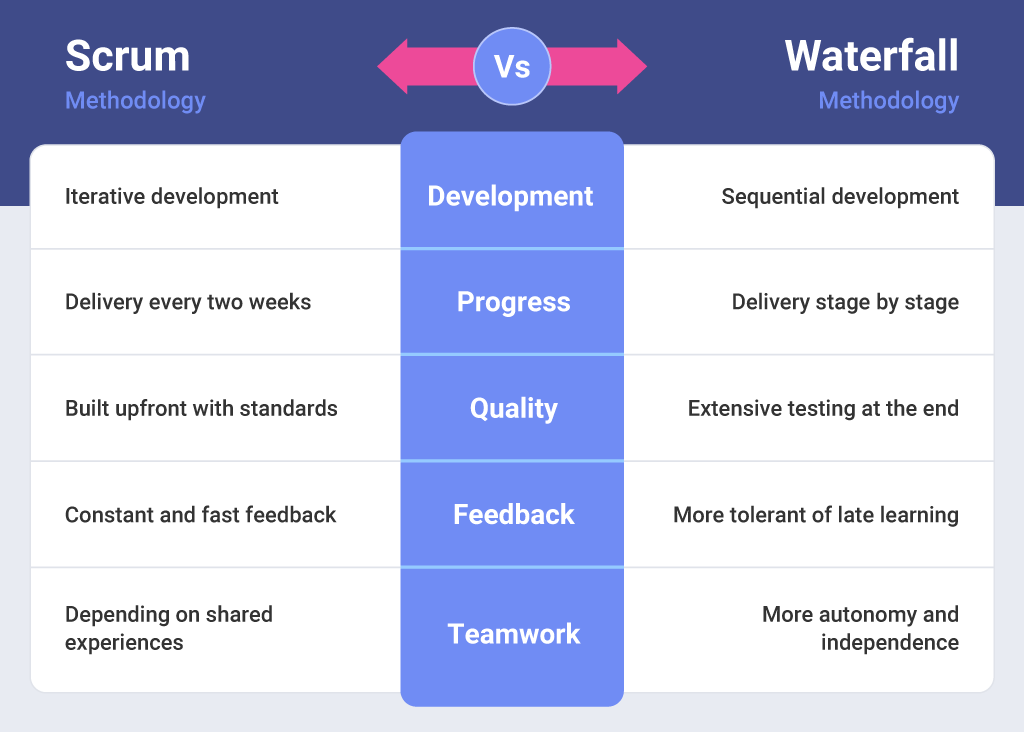
- Development – with Scrum we have iterative development and with Waterfall it’s sequential
- Progress – with Scrum we see the progress by the delivery of valued features every two weeks and with Waterfall, there are reports on each stage and activity
- Quality – with Scrum quality is built upfront with standards and with Waterfall, product quality is defined with extensive testing at the end
- Feedback – Scrum is organized around constant feedback to the team and fast; Waterfall is more tolerant of late learning
- Teamwork – Scrum uses cross-functional teams with common knowledge of the product and shared experiences and Waterfall works with knowledge stored in documents and a lot more autonomy and independence
Choosing Waterfall or Scrum for Your Business: A Look at Slingshot
After taking a closer look at the Waterfall and Scrum methodologies, the question of which one works best for your team should be much easier to answer. However, each project manager’s job is to implement whatever method they choose in the right way, using the tools and software that creates the environment for that implementation.
Besides a project management tool, Slingshot is a digital workspace that could make the implementation of both Waterfall and Scrum easy through:
- Keeping files at one spot – always needing the right and most recently updated documentation is a reality in every team’s daily work. Slingshot has integrated all your cloud providers, allowing for the upload and/or linking to any file – so each team member has access to the most recently updated files on a task level
- Defined tasks – Slingshot lets you organize tasks and have the whole project outlined from start to finish, with all files available, discussions in chat, and clear dependencies, blockers, and subtasks
- Data analysis at every step – if we take a look at Slingshot in its collaboration app characteristics, it essentially can serve as project management central, connecting all needed insights for your team – task tracking, due dates, paid campaign results, project progress, and discussions in the context
- Clear accountability and due dates – expectations of the whole process are easily managed in Slingshot, with a clear outline of due dates (if you’re using Scrum and you have two-week sprints) and transparency on accountability
- KanBan view of tasks – KanBan is one of the view types in Slingshot that provides the clearest overview of what is due and when, and where each task is in terms of progress (to do, in progress, in review, blocked, completed)
- Aggregated task view – with Slingshot, you have the option to create filters, save them and use them to bring up tasks from all relevant sub-workspaces, connected to a project, so you can run not just individual projects but an entire team
Try Slingshot today to experiment and learn what works best for your team in any circumstance.
Related Articles
Ready to grow your business 10x with AI decision-making?
Request a Free Demo of SlingshotSHARE THIS POST




